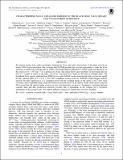CHARACTERIZING X-RAY AND RADIO EMISSION IN THE BLACK HOLE X-RAY BINARY V404 CYGNI DURING QUIESCENCE
Author(s)
Rana, Vikram; Loh, Alan; Corbel, Stephane; Tomsick, John A.; Chakrabarty, Deepto; Walton, Dominic J.; Barret, Didier; Boggs, Steven E.; Christensen, Finn E.; Craig, William; Fuerst, Felix; Gandhi, Poshak; Grefenstette, Brian W.; Hailey, Charles; Harrison, Fiona A.; Madsen, Kristin K.; Rahoui, Farid; Stern, Daniel; Tendulkar, Shriharsh; Zhang, William W.; ... Show more Show less
DownloadRana-2016-CHARACTERIZING X-RAY.pdf (885.9Kb)
PUBLISHER_POLICY
Publisher Policy
Article is made available in accordance with the publisher's policy and may be subject to US copyright law. Please refer to the publisher's site for terms of use.
Terms of use
Metadata
Show full item recordAbstract
We present results from multi-wavelength simultaneous X-ray and radio observations of the black hole X-ray binary V404 Cyg in quiescence. Our coverage with NuSTAR provides the very first opportunity to study the X-ray spectrum of V404 Cyg at energies above 10 keV. The unabsorbed broadband (0.3–30 keV) quiescent luminosity of the source is 8.9 × 10³² erg s⁻¹ for a distance of 2.4 kpc. The source shows clear variability on short timescales (an hour to a couple of hours) in the radio, soft X-ray, and hard X-ray bands in the form of multiple flares. The broadband X-ray spectra obtained from XMM-Newton and NuSTAR can be characterized with a power-law model having a photon index of Γ = 2.12 ± 0.07 (90% confidence errors); however, residuals at high energies indicate spectral curvature significant at a 3σ confidence level with the e-folding energy of the cutoff as 20⁺²⁰₋₇ keV. Such curvature can be explained using synchrotron emission from the base of a jet outflow. Radio observations using the VLA reveal that the spectral index evolves on very fast timescales (as short as 10 minutes), switching between optically thick and thin synchrotron emission, possibly due to instabilities in the compact jet or stochastic instabilities in the accretion rate. We explore different scenarios to explain this very fast variability.
Date issued
2016-04Department
Massachusetts Institute of Technology. Department of Physics; MIT Kavli Institute for Astrophysics and Space ResearchJournal
Astrophysical Journal
Publisher
Institute of Physics Publishing (IOP)
Citation
Rana, Vikram, Alan Loh, Stephane Corbel, John A. Tomsick, Deepto Chakrabarty, Dominic J. Walton, Didier Barret, et al. “CHARACTERIZING X-RAY AND RADIO EMISSION IN THE BLACK HOLE X-RAY BINARY V404 CYGNI DURING QUIESCENCE.” The Astrophysical Journal vol. 821, no. 2, 103, April 2016, pp. 1-10.
Version: Final published version
ISSN
1538-4357
0004-6256